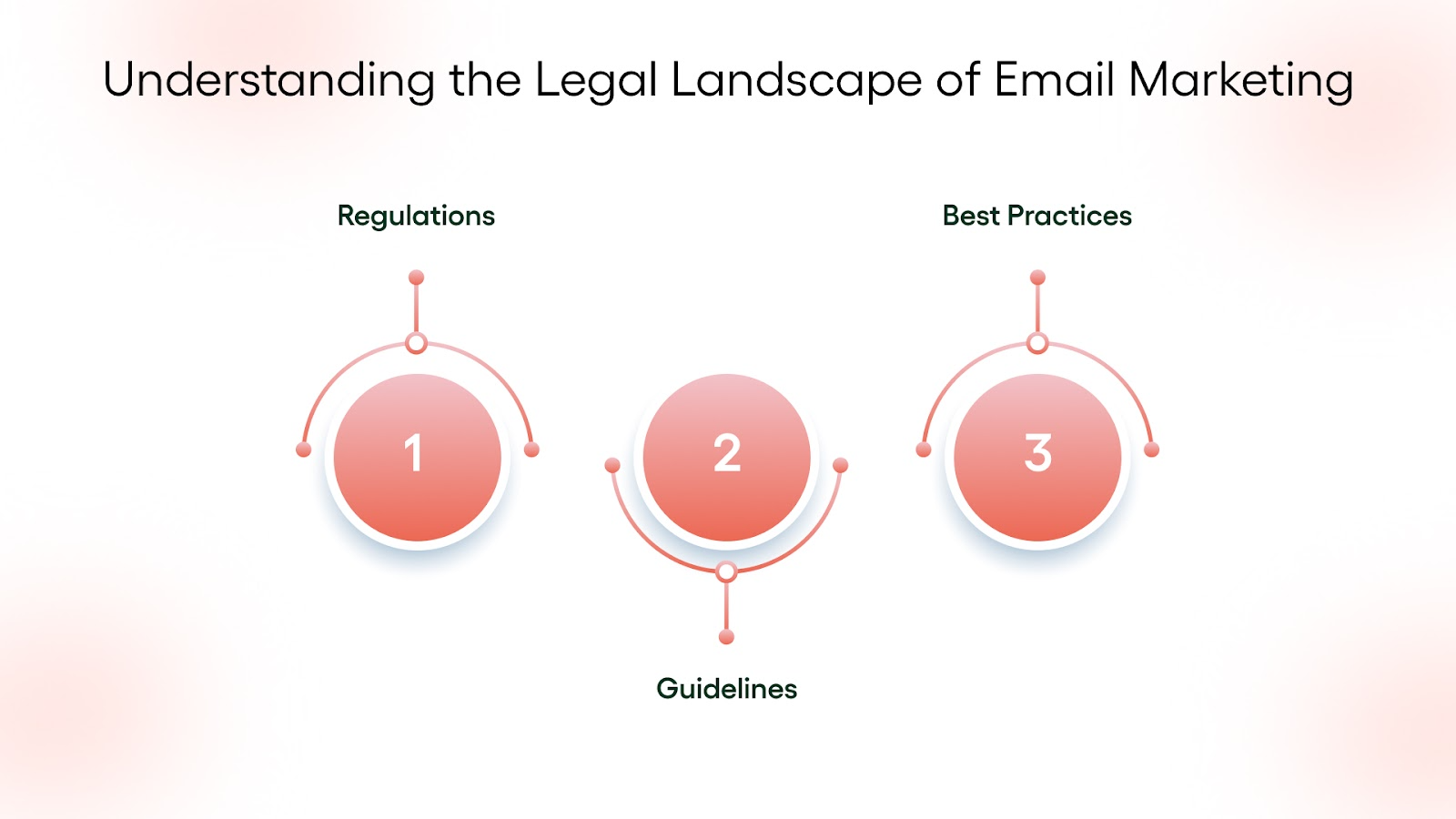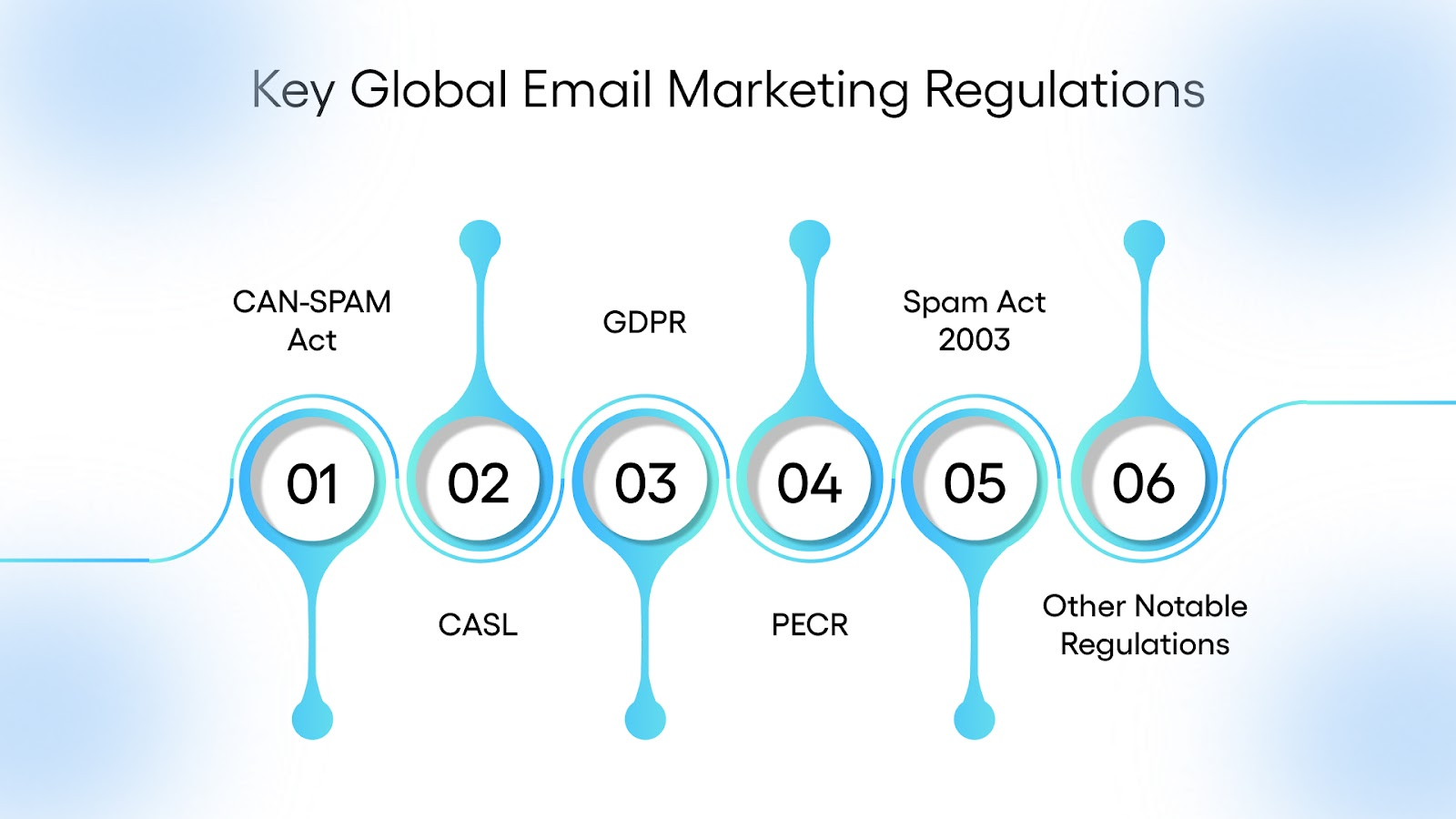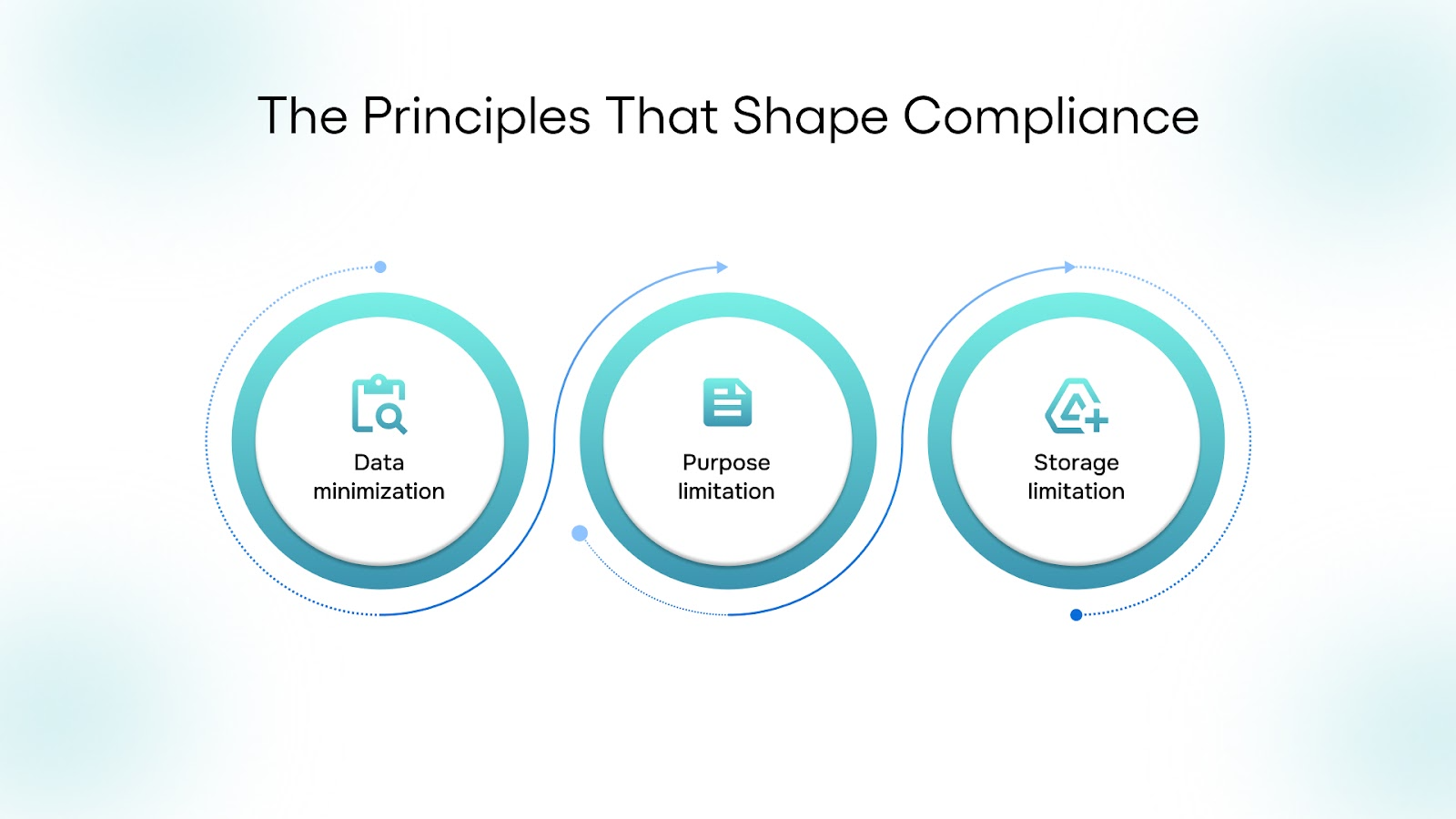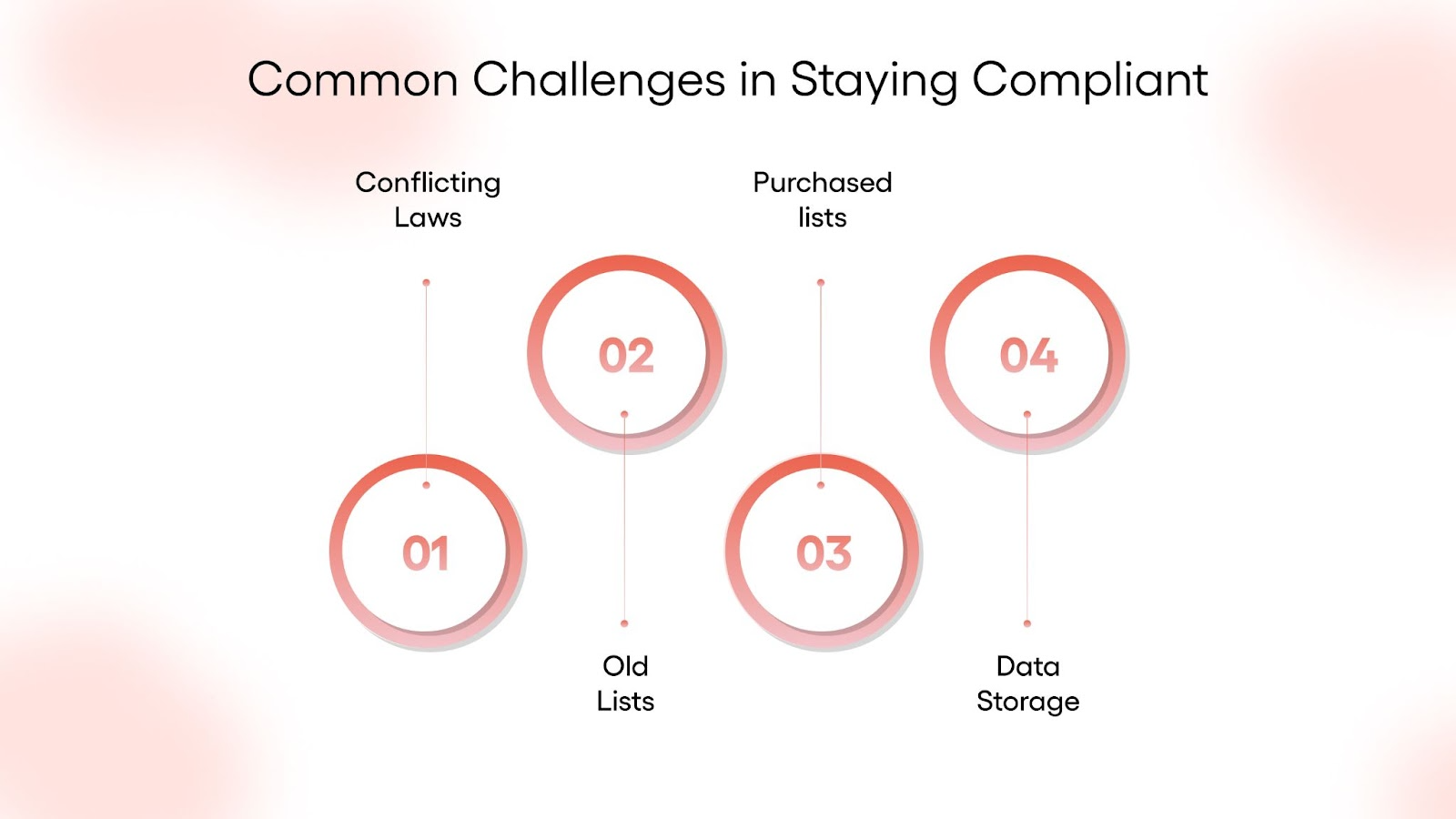
Understanding Email Marketing Rules and Regulations
.jpg)
Email is one of the most heavily used communication tools in business, but it’s also one of the most abused. In 2023, spam made up about 47% of global email traffic. A significant share of these messages contained phishing attempts, and business email compromise attacks were linked to losses exceeding $2.9 trillion in 2023 (The SSL Store, 2024).
These numbers explain why governments created laws to set standards for commercial email. Regulations aim to stop deceptive practices, reduce spam, and protect personal information. Without them, inboxes would be flooded with unwanted or unsafe messages, and trust in email as a marketing tool would decline. Stricter rules also help level the playing field, making it harder for fraudulent senders to compete with legitimate businesses. For marketers, this means compliance isn’t just about legal safety; it’s part of keeping the email channel usable and effective for everyone.
Key Takeaways:
- Almost half of all global email traffic is spam, which is why strict regulations exist.
- The main laws to know are CAN-SPAM (US), CASL (Canada), GDPR (EU), PECR (UK), Spam Act (Australia), plus CCPA, PDPA, and New Zealand’s UEM Act.
- The US allows an opt-out model, while most other regions require explicit opt-in with proof.
- Unsubscribe links must be clear, easy to use, and processed quickly; most regions expect immediate action.
- Email addresses are legally treated as personal data, which means they fall under privacy and data protection rules.
- Compliance gets tricky with old or purchased lists, missing consent records, or platforms storing data in the wrong country.
- The most reliable practices are permission-based signups, consistent forms across all channels, regular list audits, and staff training.
- Following the rules isn’t just about avoiding fines; it’s what keeps inboxes open to your messages.
Understanding the Legal Landscape of Email Marketing

When you hit “send” on a campaign, you’re not just writing to people in one country. A single email can appear in inboxes across Europe, North America, and Australia in seconds. That reach is powerful, but it also means you’re stepping into multiple legal systems at once. What passes in the U.S. under CAN-SPAM might breach the stricter rules of the GDPR in Europe, or conflict with Canada’s Anti-Spam Law.
This overlap is what makes compliance non-negotiable. Ignore it, and you risk more than an annoyed subscriber; you could face fines, legal disputes, or end up with your emails blocked altogether. Respecting these laws isn’t just about protecting your business; it’s about treating your audience’s trust as something worth keeping.
Regulations vs. Guidelines vs. Best Practices
These terms are often used interchangeably, but they carry distinct meanings.
Regulations
These are actual laws, enforceable by governments. CAN-SPAM, GDPR, and CASL are the big names most marketers know. They set the minimum bar: consent, transparency, unsubscribe options, and data protection. Break these, and there are direct consequences.
Guidelines
These come from industry groups such as M3AAWG. They’re not legally binding, but they reflect the standards mailbox providers and email experts pay attention to. Ignore them, and you might not end up in court, but your messages may never make it past the spam filter.
Best Practices
These go a step further. They’re habits that seasoned marketers adopt because they’ve seen what works and what fails. Things like sending at a reasonable frequency, writing clear subject lines, or confirming sign-ups through double opt-in. They’re not laws, and they’re not rules from a committee; they’re the tested methods that help build deliverability and long-term trust.
Think of it this way: regulations keep you legal, guidelines keep you in good standing with the ecosystem, and best practices keep you welcome in the inbox. Skip any one of them, and your emails either risk being illegal, unseen, or unwanted.
Main Global Laws to Know

Before we get into the fine print, here are the core regulations that shape email marketing worldwide:
- CAN-SPAM (United States): Sets rules for commercial email, focusing on clear sender identity, honest subject lines, and opt-out rights.
- CASL (Canada): One of the strictest regimes, requiring express consent before sending most marketing emails.
- GDPR (European Union): A broad data protection law covering consent, data rights, and handling of personal information.
- PECR (United Kingdom): Works alongside GDPR, with added rules on direct marketing, cookies, and tracking.
- Spam Act 2003 (Australia): Requires consent, proper sender identification, and a working unsubscribe option.
- Other Notables: Singapore’s PDPA (Do Not Call rules), California’s CCPA (consumer data rights), and New Zealand’s UEM Act (consent-focused with monetary penalties).
These are the foundations. The next section breaks each one down with practical requirements, unique twists, and the costs of getting it wrong.
Read: The Best Lead Generation Tools for 2025
Key Global Email Marketing Regulations

No inbox is governed by a single law. The rules that shape email marketing differ country by country, but they often overlap in ways that make compliance tricky. What ties them together is a focus on consent, transparency, and accountability, but the way each law defines those terms can feel very different.
CAN-SPAM Act (United States)
When the U.S. introduced CAN-SPAM in 2003, it took a very different route from the rest of the world. Unlike Europe or Canada, it doesn’t demand prior consent to send marketing messages. Instead, it focuses on honesty and choice: you can email first, but you must not lie about who you are, and you must give people a straightforward way to make you stop.
That means no fake “From” names, no trick subject lines, and every message must carry a physical mailing address and an unsubscribe link that actually works.
At TLM (The Lead Market), CAN-SPAM isn’t treated as the end of the conversation. It’s the minimum standard we build on. In practice, that means keeping lists clean, honoring opt-outs quickly, and setting up campaigns in a way that mailbox providers respect. Those details don’t just keep us compliant, they make sure the emails we send on behalf of clients actually land where they’re supposed to.
Read: How to Build Effective B2B Email Lists + Top Tools
CASL – Canada’s Anti-Spam Legislation
Enacted in 2014, CASL requires express consent, or limited implied consent, such as a purchase within the last two years, before sending commercial emails. Silence does not qualify as consent.
Compliance also depends on strict record-keeping. Businesses must retain proof of consent, including timestamps, forms, and logs, as regulators may request documentation. Enforcement has been stringent, with penalties reaching millions of dollars. For marketers, CASL makes poor data practices not only a deliverability risk but also a legal liability.
GDPR – General Data Protection Regulation (European Union)
GDPR reshaped not just email, but the entire way businesses handle personal data. Introduced in 2018, it applies far beyond Europe’s borders. If even one subscriber on your list lives in the EU, you’re expected to comply.
For email, GDPR zeroes in on consent. It must be explicit, specific, and freely given. Pre-ticked boxes or vague opt-ins don’t cut it. And once consent is given, subscribers retain control: they can ask to see what data you hold, request corrections, demand deletion, or even move their data elsewhere.
The financial stakes are enormous, fines climb as high as four percent of global revenue, but the reputational stakes are often higher. GDPR has set a cultural expectation worldwide: people now assume they have rights over their data, whether the local law enforces it or not.
PECR – Privacy and Electronic Communications Regulations (United Kingdom)
In the UK, GDPR is supplemented by PECR, which establishes additional rules for marketing and electronic tracking. A key aspect of PECR is its regulation of cookies and tracking pixels. Even when marketing emails are sent lawfully, tracking technologies cannot be used without clear disclosure and consent.
The Information Commissioner’s Office has issued fines not only for unsolicited emails but also for undisclosed tracking practices embedded in communications. For organizations, PECR underscores that consent to receive messages does not extend to consent for monitoring user behavior.
Spam Act 2003 (Australia)
Australia takes a pragmatic approach to regulating commercial email. The Spam Act requires consent, either express or inferred, along with clear sender identification and a functional unsubscribe option. While those elements are common in many jurisdictions, enforcement in Australia is notably strict. Companies can face fines in the millions per day for serious or repeated breaches, and regulators have acted against large telcos and household brands for non-compliance.
An additional industry code of practice reinforces these rules by requiring businesses to keep detailed consent records and handle complaints effectively. In practice, the law combines strict legal standards with an expectation of fair customer service.
Other Notable Regulations
California’s CCPA gives residents rights to access, delete, and restrict the sale of their data. Singapore’s PDPA combines data protection with a Do Not Call registry, adding extra requirements before marketing messages can be sent. New Zealand’s UEM Act requires consent and imposes penalties of up to NZD 500,000 on companies.
Definitions of consent, retention periods, and penalty scales differ, but the principle is consistent worldwide: consent, transparency, and accountability are mandatory. Organizations that rely only on domestic minimums risk non-compliance in an international email environment.
Read: How to Optimize Email Cadence for Better Results?
Consent & Opt-In Requirements
Consent sits at the heart of email marketing. It’s the difference between a message someone expects and a message that feels like an intrusion. But “consent” doesn’t mean the same thing everywhere, and it’s often misunderstood.
What Counts as Valid Consent
To be meaningful, consent has to be active, informed, and specific. A pre-ticked box on a form, or the absence of an objection, doesn’t qualify. People need to know what they’re signing up for, and businesses need to be able to prove it later if asked. That means documenting not only the fact that someone agreed, but also how and when they agreed.
In Europe and Canada, regulators routinely ask for this kind of proof. If you can’t show the signup source, timestamp, and method, it’s as if the consent never existed. That’s why responsible senders keep detailed logs, rather than relying on vague assurances like “they must have signed up at some point.”
Single vs. Double Opt-In
This is where compliance meets strategy.
- Single opt-in lets someone join your list after one step, typically submitting an email on a form. It’s fast and it grows lists quickly, but it opens the door to typos, bots, or even competitors signing up addresses that don’t belong to them. That leads to higher bounce rates, spam complaints, and weaker proof of consent.
- Double opt-in adds a confirmation step: after signing up, the person has to click a link in a confirmation email. It slows list growth a little, but it creates a record that’s hard to dispute. Regulators and mailbox providers both see this as stronger evidence that the person wanted your emails.
Neither approach is “wrong,” but the choice says a lot about priorities. Companies chasing raw volume often prefer single opt-in. Companies looking for cleaner engagement and stronger compliance lean toward double.
Regional Models of Consent

Consent rules vary sharply across borders:
- United States: CAN-SPAM works on an opt-out model. You can send marketing emails until the recipient tells you to stop.
- European Union and Canada: Both use strict opt-in models. You cannot send marketing messages unless the person has clearly said “yes” in advance.
- Australia and New Zealand: Similar to the EU/Canada model, requiring consent before sending.
- Singapore: Requires marketers to check national Do Not Call registries in addition to consent rules.
For global campaigns, this patchwork matters. If your list spans multiple regions, the safest route is to adopt the strictest standard (express opt-in with proof) and apply it everywhere.
Keeping Records of Consent
Maintaining consent records isn’t just about legal defense. It’s about operational clarity. A good record should show:
- The signup source (form, landing page, in-store tablet, etc.).
- The date and time.
- The method (single opt-in, double opt-in, etc.).
- Any disclosures shown at the point of signup.
Well-kept records help when regulators come knocking, but they also make internal life easier. If a customer complains about receiving unwanted mail, you can trace the signup event and respond confidently. Without that, you’re left scrambling.
Consent is more than a legal safeguard. It’s the foundation of how people experience your emails. When it’s clear, documented, and respected, campaigns build trust and stay welcome in the inbox. When it’s vague or poorly recorded, the risks, legal, financial, and reputational, pile up quickly.
Opt-Out & Unsubscribe Compliance
How you let people leave your list matters. If the unsubscribe link is hidden, hard to find, or doesn’t work properly, you’re not just risking irritation; you’re risking legal trouble.
Clear and Simple Design
The best approach is one click, easy to spot. The link should appear in both the HTML and plain-text versions of your message. If someone wants to stop hearing from you, they shouldn’t have to scroll endlessly, decipher tiny print, or click on an image that might not even load.
How Fast It Must Happen
Different laws set different deadlines for processing an unsubscribe request:
- United States (CAN-SPAM): You have up to 10 business days.
- European Union (GDPR): Must be honored without undue delay, effectively immediate.
- Canada (CASL): Same as the EU, requests must take effect right away.
Even though U.S. law allows more time, waiting that long rarely makes sense. Most people expect to stop receiving emails as soon as they click the link. Delay only leads to complaints and “Report Spam” clicks.
What You Cannot Do
Some practices are explicitly banned across jurisdictions:
- Charging people to unsubscribe.
- Forcing them to log in to an account first.
- Making them send a reply email or fill out a form.
- Hiding the unsubscribe in an image or behind confusing wording.
These are seen as intentional barriers, and regulators treat them as violations. An email list is only as strong as the people who want to be on it. Keeping disengaged or unwilling subscribers drags down open rates and hurts deliverability. Making it easy to leave may feel counterintuitive, but it protects both your reputation and your ability to reach the audience that actually wants your emails.
The Principles That Shape Compliance

The GDPR outlines a set of principles that apply whenever you collect or process personal data. For email marketing, three stand out:
- Data minimization: Collect only what you truly need. If your campaign requires just an email address, don’t also ask for date of birth, phone number, or home address unless there’s a clear reason.
- Purpose limitation: Use the data only for the purpose you stated at collection. If someone signed up for a weekly newsletter, you can’t automatically add them to promotional blasts unless you made that purpose clear upfront.
- Storage limitation: Keep data only as long as it’s necessary. That means pruning old lists, removing inactive subscribers, and not holding on to addresses indefinitely “just in case.”
These principles may sound abstract, but they shape real-world practices. Marketers who ignore them risk both legal penalties and losing customer trust.
Moving Data Across Borders
For businesses that collect subscribers globally, data rarely stays in one country. Servers, CRMs, and marketing platforms often move it across borders. The GDPR treats these transfers seriously. If personal data leaves the European Economic Area, the receiving country must have adequate protections.
Most U.S.-based companies rely on Standard Contractual Clauses (SCCs), legal agreements approved by the EU, to legitimize transfers. Others may use Binding Corporate Rules or specific derogations, though these are less common. The Schrems II ruling in 2020 invalidated the EU–U.S. Privacy Shield, underscoring how volatile and important cross-border safeguards are.
Who Holds Responsibility: Controller vs. Processor
Another area many marketers overlook is the distinction between data controllers and data processors:
- The controller decides why and how personal data is processed. For email marketing, that’s usually the business running the campaign.
- The processor handles the data on behalf of the controller. That could be an email service provider, CRM, or marketing agency.
Knowing your role is crucial, because the responsibilities differ. Controllers must ensure there’s a lawful basis for collecting and using email addresses. Processors must follow the controller’s instructions and implement security safeguards. If you’re not sure which role your organization plays, you’re already at risk of mishandling your obligations.
Email addresses may feel like simple strings of text, but regulators treat them as protected personal data. How you collect, store, share, and delete them carries real legal weight. Treating email as part of the larger privacy picture — not just a marketing asset — is what keeps campaigns compliant and trusted.
Common Challenges in Staying Compliant

Even businesses with the best intentions run into hurdles when it comes to email compliance. The landscape is complex, and mistakes often come from misunderstanding rather than neglect. Recognizing the most common pitfalls can save a lot of trouble down the road.
- Conflicting laws for international campaigns: A single newsletter can hit inboxes in multiple countries, each with its own rules. The U.S. allows an opt-out model, while Canada and the EU demand explicit opt-in. That means one-size-fits-all campaigns can create compliance gaps. Companies sending globally often find themselves forced to adopt the strictest standards everywhere, not because it’s easy, but because it’s the only safe way to scale.
- Old email lists with no proof of consent: Legacy lists are a liability. If you can’t prove how someone joined, regulators may treat the entire list as non-compliant. Beyond the legal risk, old lists often drag down deliverability because inactive addresses trigger spam filters. The “but they’ve been with us forever” defense doesn’t hold water, what matters is evidence of consent.
- Purchased lists: Buying addresses is legal in some regions, but it’s always risky. Consent doesn’t transfer with a sale, and recipients rarely expect to hear from you. More often than not, purchased lists lead to high complaint rates, deliverability issues, and reputational damage that outweigh any short-term gain.
- Third-party platforms storing data abroad: Many businesses rely on CRMs, ESPs, or cloud services without checking where the servers sit. Under GDPR, for example, sending subscriber data outside the EU requires specific safeguards. A business may think it’s compliant in its own practices, but if the platform it uses stores data in the wrong jurisdiction, that chain can break.
Compliance isn’t just about what you send; it’s about the history of your list, the tools you use, and the global patchwork of rules you operate within. Knowing where the traps lie makes it far easier to avoid them.
Read: Complete Guide to A/B Testing for Email Campaigns
Best Practices for Ethical & Legal Email Marketing

The strongest email strategies don’t stop at bare compliance. They build trust, protect deliverability, and give subscribers a reason to stay engaged. These practices aren’t about ticking boxes; they’re about making email a sustainable channel.
- Build from permission-based opt-ins only
Start with genuine consent, not shortcuts. Whether it’s a signup form, event registration, or download, be clear about what people are agreeing to. That clarity not only satisfies regulators but sets the tone for the relationship. - Unify consent collection across channels
Email addresses often enter your system from different sources: websites, live events, and social campaigns. If the process isn’t consistent, you risk uneven records and gaps in compliance. Syncing language and disclosures across all entry points creates a clear trail. - Audit lists regularly
Lists aren’t static. People move, abandon accounts, or lose interest. By periodically removing inactive or unverifiable contacts, you protect deliverability and reduce the chance of mailing people who no longer expect to hear from you. - Train staff at every level
Compliance isn’t just the legal team’s job. Sales teams, event organizers, and anyone handling leads should understand the basics of consent, data handling, and unsubscribe rights. One weak link can undo everyone else’s effort. - Keep an eye on enforcement trends
Regulators publish decisions and fines that often reveal how they interpret the rules. Monitoring those cases helps you adapt before you find yourself in similar circumstances.
Best practices aren’t abstract ideals; they’re practical habits that protect both sender and subscriber. By embedding them into daily work, businesses make compliance part of the culture rather than a scramble after the fact.
Wrapping Up
Email regulations are often treated as a formality, but they play a decisive role in campaign performance. Compliance goes beyond avoiding fines; it determines whether messages reach the inbox, whether audiences trust the sender, and whether email remains a dependable channel over time.
The practical next step for any business is an audit:
- Can you prove how every subscriber joined your list?
- Are your unsubscribe processes immediate and simple?
- Do you know where your platforms store data?
- Are you applying the strictest rules across borders, rather than patchworking by region?
Compliance begins with addressing these questions transparently. While regulations continue to evolve, through GDPR updates, new U.S. state laws, and stricter standards in the Asia-Pacific region, organizations that build on the foundations of consent, clarity, and accountability will be prepared to adapt rather than react.
At The Lead Market (TLM), we don’t stop at compliance. We turn it into an advantage, designing campaigns that meet legal standards while also generating sales-qualified leads, booked appointments, and lasting relationships with the right prospects. Discover how TLM can support your growth.
FAQs
1. Is it legal to use purchased email lists?
In the U.S., purchased email lists are not outright illegal under CAN-SPAM. In the EU, Canada, Australia, and many other regions, they cannot be used without prior consent. Even where legal, they damage deliverability and reputation, often leading to spam complaints and wasted spend.
2. Do I need double opt-in everywhere?
No law explicitly requires double opt-in, but in places like the EU and Canada, it provides the strongest proof of consent if challenged. In the U.S., single opt-in is common, but many companies adopt double opt-in globally for consistency and deliverability.
3. How long can I keep subscriber data?
Under GDPR’s storage limitation principle, you should only keep personal data (including emails) as long as it’s necessary for the stated purpose. If a subscriber is inactive for years and never re-engages, keeping them indefinitely becomes harder to justify. Regular list-cleaning is both legally safer and better for performance.
4. What happens if my ESP or CRM stores data outside my country?
You remain responsible as the data controller. If you’re in the EU, for instance, and your provider stores data in the U.S., you must have safeguards like Standard Contractual Clauses (SCCs) in place. Choosing vendors who can document their compliance is part of your legal duty.
5. How do unsubscribe complaints affect deliverability?
Even if you’re technically compliant, high unsubscribe or spam-complaint rates signal to Gmail, Outlook, and other providers that your messages aren’t wanted. That often leads to bulk filtering or junk folder placement. Compliance alone doesn’t guarantee inboxing; engagement metrics matter just as much.






